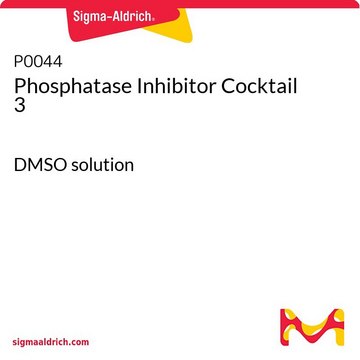05-517
Anti-PTH/PTHrP Receptor Antibody, clone 3D1.1
clone 3D1.1, Upstate®, from mouse
Synonym(s):
Anti-BDE2, Anti-HHM, Anti-PLP, Anti-PTHR, Anti-PTHRP
Sign Into View Organizational & Contract Pricing
Select a Size
All Photos(1)
Select a Size
Change View
About This Item
UNSPSC Code:
12352203
eCl@ss:
32160702
NACRES:
NA.41
Recommended Products
biological source
mouse
Quality Level
antibody form
purified immunoglobulin
antibody product type
primary antibodies
clone
3D1.1, monoclonal
species reactivity
pig, human, mouse
manufacturer/tradename
Upstate®
technique(s)
immunohistochemistry: suitable
western blot: suitable
isotype
IgG1κ
NCBI accession no.
Specificity
Recognizes PTH/PTHrP receptor and the receptor dimer.
Immunogen
Synthetic peptide corresponding to amino acids 146-169 of the human PTH/PTHrP (parathyroid hormone/parathyroid hormone related protein) receptor (RRCDRNGSWELVPGHNRTWANYSE).
Application
Anti-PTH/PTHrP Receptor Antibody, clone 3D1.1 is an antibody against PTH/PTHrP Receptor for use in IH & WB.
Research Category
Neuroscience
Neuroscience
Research Sub Category
Hormones & Receptors
Hormones & Receptors
Quality
Routinely evaluated by immunoblot on RIPA lysates of 3T3-L1 pre-adipose fibroblasts
Target description
80 kDa; receptor dimer at 160 kDa
Physical form
Format: Purified
Protein G Purified
Protein G Purified immunoglobulin in Immunoaffinity Purified immunoglobulin in 0.2M Tris-glycine, pH 7.4, 0.15M NaCl, 0.05% sodium azide before the addition of glycerol to 30%
Storage and Stability
Maintain for 2 years at -20°C from date of shipment. Aliquot to avoid repeated freezing and thawing. For maximum recovery of product, centrifuge the original vial after thawing and prior to removing the cap.
Analysis Note
Control
Kidney Tissue
Kidney Tissue
Other Notes
Concentration: Please refer to the Certificate of Analysis for the lot-specific concentration.
Legal Information
UPSTATE is a registered trademark of Merck KGaA, Darmstadt, Germany
Disclaimer
Unless otherwise stated in our catalog or other company documentation accompanying the product(s), our products are intended for research use only and are not to be used for any other purpose, which includes but is not limited to, unauthorized commercial uses, in vitro diagnostic uses, ex vivo or in vivo therapeutic uses or any type of consumption or application to humans or animals.
Not finding the right product?
Try our Product Selector Tool.
Storage Class Code
10 - Combustible liquids
WGK
WGK 1
Certificates of Analysis (COA)
Search for Certificates of Analysis (COA) by entering the products Lot/Batch Number. Lot and Batch Numbers can be found on a product’s label following the words ‘Lot’ or ‘Batch’.
Already Own This Product?
Find documentation for the products that you have recently purchased in the Document Library.
Christine V Marzan et al.
Developmental biology, 349(2), 125-136 (2010-10-27)
We generated a transgenic (Tg)-mouse model expressing a dominant negative-(DN)-RARα, (RARαG303E) under adipocytes-specific promoter to explore the paracrine role of adipocyte retinoic acid receptors (RARs) in mammary morphogenesis. Transgenic adipocytes had reduced level of RARα, β and γ, which coincided
Cell-specific effects of nitric oxide deficiency on parathyroid hormone-related peptide (PTHrP) responsiveness and PTH1 receptor expression in cardiovascular cells.
Rolf Schreckenberg, Sibylle Wenzel, Rui Manuel da Costa Rebelo, Anja Rothig, Rainer Meyer et al.
Endocrinology null
Altered ovarian function affects skeletal homeostasis independent of the action of follicle-stimulating hormone.
Gao, J; Tiwari-Pandey, R; Samadfam, R; Yang, Y; Miao, D; Karaplis, AC; Sairam, MR; Goltzman, D
Endocrinology null
Nathalie Alekos et al.
JCI insight (2023-02-03)
The energetic costs of bone formation require osteoblasts to coordinate their activities with tissues, like adipose, that can supply energy-dense macronutrients. In the case of intermittent parathyroid hormone treatment (PTH), a strategy used to reduce fracture risk, bone formation is
Kimberly J Curtis et al.
Journal of the Royal Society, Interface, 17(173), 20200568-20200568 (2020-12-17)
Most patients who succumb to cancer have metastases to bone that contribute to their death. Cancer cells that metastasize to bone are regularly subjected to mechanical stimuli that may affect their proliferation, growth and protein expression. Understanding why some cancer
Our team of scientists has experience in all areas of research including Life Science, Material Science, Chemical Synthesis, Chromatography, Analytical and many others.
Contact Technical Service






![Western Blocking Reagent, Solution solution, sufficient for 10 blots (11921673001 [100 cm2]), sufficient for 60 blots (11921681001 [100 cm2])](/deepweb/assets/sigmaaldrich/product/images/352/091/ef743cea-ccd8-44f1-8f3b-dec5a1e4f5d1/640/ef743cea-ccd8-44f1-8f3b-dec5a1e4f5d1.jpg)

